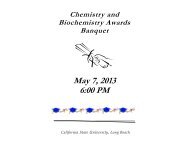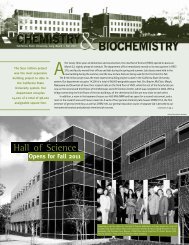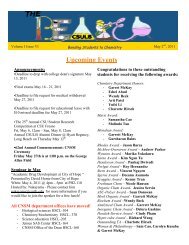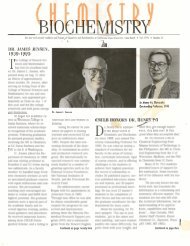2010 - California State University, Long Beach Department of ...
2010 - California State University, Long Beach Department of ...
2010 - California State University, Long Beach Department of ...
You also want an ePaper? Increase the reach of your titles
YUMPU automatically turns print PDFs into web optimized ePapers that Google loves.
Remarks<br />
by the Chair<br />
Greetings to all the alumni and<br />
friends <strong>of</strong> the <strong>Department</strong> <strong>of</strong> Chemistry<br />
and Biochemistry. It has been a<br />
challenging year for the department, but<br />
we are working hard to maintain a quality<br />
program in the face <strong>of</strong> reduced state support.<br />
This year, we were able to <strong>of</strong>fer a full<br />
schedule <strong>of</strong> classes, and next year, we should<br />
be able to restrict cuts to our General Education<br />
(CHEM 100) and Preparative Chemistry<br />
(CHEM 101) classes. We were able to<br />
survive a year <strong>of</strong> faculty and staff furloughs,<br />
including three days each semester when<br />
the university was closed and all classes<br />
were cancelled.<br />
There have been plenty <strong>of</strong> bright spots<br />
as well. Our faculty had continued success in<br />
publishing the results <strong>of</strong> their research,<br />
obtaining external funding and receiving<br />
honors in recognition <strong>of</strong> their work. We added<br />
an isothermal titration calorimeter and a<br />
powder X-ray diffractometer to our facilities.<br />
Fifty <strong>of</strong> our students graduated with bachelor’s<br />
degrees, and nine <strong>of</strong> our students completed<br />
their M.S. degree programs. Our students<br />
continued to be involved in large numbers in<br />
research, co-authoring publications and<br />
making presentations at national meetings.<br />
We had an outstanding Distinguished<br />
Lecturer program, featuring a visit from Dr.<br />
Irwin Rebek, Jr. <strong>of</strong> the Scripps Institute. We<br />
held our first alumni reunion in many years.<br />
We have seen a substantial increase in<br />
contributions to the department by our<br />
alumni and friends. Finally, we have had the<br />
pleasure <strong>of</strong> watching the new Hall <strong>of</strong> Science<br />
rise in between PH2 and the Molecular and<br />
Life Sciences Center, and we look forward to<br />
moving into the building next spring and<br />
summer. Our students continue to gain<br />
acceptance to leading graduate and<br />
pr<strong>of</strong>essional schools.<br />
At the alumni reunion banquet, I presented<br />
a comparison between the department<br />
in 1975-76, the year I joined the<br />
faculty, and today.<br />
Dr. Jeffrey A. Cohlberg<br />
• In 1975, the prime activity <strong>of</strong> a<br />
chemist was using a fine wire to unclog<br />
the pen on a chart recorder, while in <strong>2010</strong><br />
it is sitting in front <strong>of</strong> a computer.<br />
• In a more serious vein, the number<br />
<strong>of</strong> our majors has increased from 164 to 476,<br />
while the number <strong>of</strong> tenure-track faculty<br />
has remained the same at 23, and the<br />
number <strong>of</strong> graduate students is also about<br />
the same (45 in 1976 and 46 this year).<br />
• The typical size <strong>of</strong> an upper-division<br />
class was under 40 in 1975, while now it is<br />
60-80.<br />
• In 1975, when research was just<br />
beginning to be required for tenure and<br />
promotion, our faculty published eight<br />
research journal articles, compared to 34<br />
in 2008-09.<br />
• In 1975, a student paid $194 a year<br />
($767 in today’s dollars) to attend CSULB;<br />
now fees are $5,008 for undergraduates<br />
and $6,040 for grad students (more than<br />
double the fees in 2000).<br />
• <strong>State</strong> funds for operating expenses<br />
have gone from $85,000 in 1975<br />
($336,000 in today’s dollars) to $38,300<br />
today (the 1975 figure does not include<br />
separate allocations for new and replacement<br />
equipment).<br />
Our department will continue to grow<br />
and evolve. We have survived budget crises<br />
in the past, and we will survive this one as<br />
well. The changes in our department at least<br />
partly reflect the changes going on in higher<br />
education everywhere. We may embrace<br />
some <strong>of</strong> the changes that are occurring more<br />
enthusiastically than we embrace others, but<br />
we can take pride in continuing to provide<br />
high-quality training in chemistry and biochemistry<br />
for this generation <strong>of</strong> students and,<br />
hopefully, the coming generations as well.<br />
Photo by Victoria Sanchez<br />
Chem/Biochem<br />
Faculty Win<br />
Recognition<br />
for Excellence<br />
Dr. Michael Schramm was named this<br />
year’s winner <strong>of</strong> the Mayfield Award for outstanding<br />
teaching at our Commencement<br />
ceremony in May. The College <strong>of</strong> Natural Sciences<br />
and Mathematics Student Council<br />
established the award in the 1990s in honor<br />
<strong>of</strong> former chemistry pr<strong>of</strong>essor Darwin Mayfield.<br />
Each spring the students hold a noontime<br />
picnic, at which they may vote for their<br />
favorite pr<strong>of</strong>essor, and this year Dr. Schramm<br />
was their choice.<br />
Dr. Lijuan Li was one <strong>of</strong> four recipients<br />
<strong>of</strong> a university Distinguished Faculty Scholarly<br />
and Creative Achievement Award, presented<br />
annually at an awards ceremony at the Walter<br />
Pyramid. Dr. Li was recognized for her highly<br />
productive research program in inorganic<br />
chemistry. Many <strong>of</strong> her publications focus on<br />
the properties <strong>of</strong> metal nitrosyl compounds,<br />
complexes in which metals are coordinated<br />
with the biologically active compound nitric<br />
oxide, which plays a major role in regulating<br />
blood pressure. Her work may have therapeutic<br />
applications.<br />
The same ceremony also honored the<br />
two recipients <strong>of</strong> a new award, the Provost’s<br />
Award for Impact Accomplishment <strong>of</strong> the<br />
Year in Research, Scholarly & Creative Activity.<br />
One <strong>of</strong> these awards went to Dr. Steve Mezyk,<br />
who was honored for his studies <strong>of</strong> chemical<br />
kinetics by pulse radiolysis, including work on<br />
the potential use <strong>of</strong> radiological techniques<br />
for wastewater decontamination.<br />
A paper from Dr. Eric Sorin’s lab,<br />
"Equilibrium conformational dynamics in an<br />
RNA tetraloop from massively parallel molecular<br />
dynamics,” was a cover article for Nucleic<br />
Acids Research. Dr. Sorin and four undergraduate<br />
students, biochemistry majors Allison<br />
DePaul and Sarav Patel, chemical engineering<br />
major Erik Thompson and mathematics/economics<br />
double major Kristin Hardeman<br />
authored the paper.<br />
Finally, Dr. Xianhui Bu has done it again—<br />
his recent Angewandte Chemie International<br />
Edition paper, “A Tale <strong>of</strong> Three Carboxylates:<br />
Cooperative Asymmetric Crystallization <strong>of</strong><br />
Three-Dimensional Microporous Framework<br />
from Achiral Precursors,” was designated a<br />
Hot Paper by the editors <strong>of</strong> the journal “for<br />
its importance in a rapidly evolving field <strong>of</strong><br />
high current interest.”<br />
3


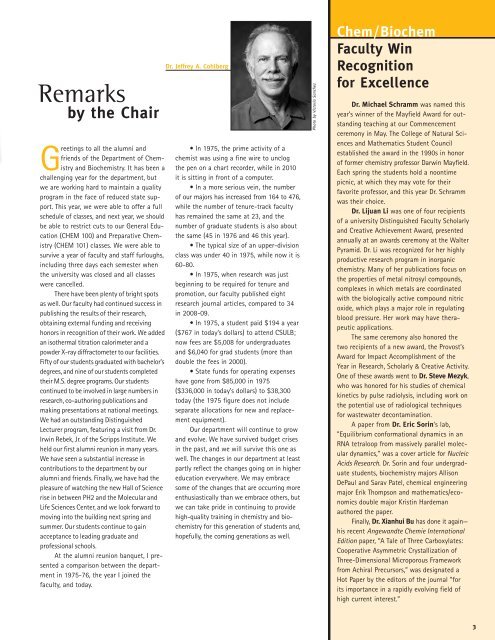
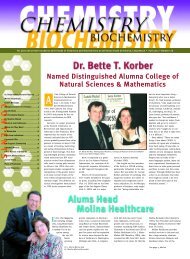
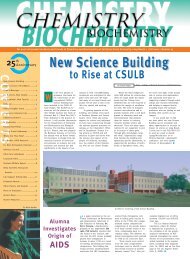
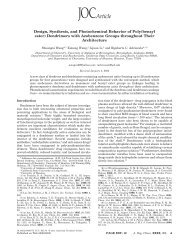
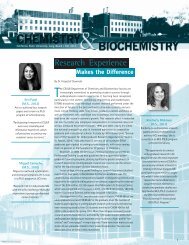
![Volume 4, Issue 3 [November 2012 pdf] - California State University ...](https://img.yumpu.com/34605825/1/190x245/volume-4-issue-3-november-2012-pdf-california-state-university-.jpg?quality=85)
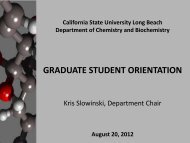
![Volume 5, Issue 2 [April 2013 pdf] - California State University, Long ...](https://img.yumpu.com/33273195/1/190x245/volume-5-issue-2-april-2013-pdf-california-state-university-long-.jpg?quality=85)
